Hello, wonderful readers! 🌿 Welcome to the colorful world of Gond Painting, a traditional art form that breathes life into the heart of Madhya Pradesh. Imagine a world where trees smile, animals dance, and every line tells a story that’s exactly what Gond art does!
Created by the Gond tribal community, this art isn’t just about painting; it’s about celebrating life and nature. Every brushstroke reflects their deep bond with forests, animals, and the divine spirits they believe guard their world. Traditionally drawn on mud walls, these paintings have now found their way to paper, canvas, and even global exhibitions yet they still carry that rustic charm of the forests.
So, as we explore this journey of dots, lines, and colors, get ready to see how imagination and tradition blend beautifully in Gond Painting: the living rhythm of tribal storytelling.
History: The Roots of Gond Painting Tradition
Gond Painting has a history as colorful as the art itself! Originating from the Gond tribe of Madhya Pradesh, this beautiful art form dates back almost 1400 years. The word “Gond” comes from the Dravidian term Kond, meaning green mountain, which perfectly reflects their deep connection with nature.
In ancient times, Gond people used to decorate the walls and floors of their huts with vibrant patterns during festivals and special occasions. These paintings were not just for beauty, they were meant to bring good luck and protect homes from evil spirits. Over time, these wall designs evolved into detailed artworks on paper and canvas.
Today, Gond Painting stands proudly as one of India’s most recognized tribal arts, blending traditional stories, myths, and beliefs into stunning visuals that continue to speak of the tribe’s rich culture and natural harmony.
🖌️ Materials Used in Gond Painting
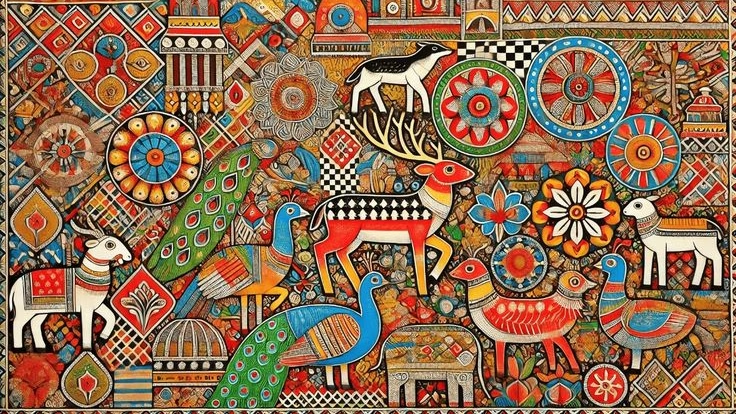
Traditionally, the materials used were completely eco-friendly and drawn from the artist’s surroundings. Over time, while modern tools have made their way in, the essence of Gond Painting remains the same, simple, natural, and soulful.
🌿 1. Natural Colours from Earth and Plants
- In the early days, Gond artists used natural colors made from leaves, flowers, stones, and soil.
- Yellow was made from chui mitti (a kind of yellow clay),
- Red came from geru mitti (red soil),
- Black was prepared by mixing soot or charcoal,
- White was obtained from powdered rice or limestone,
- Green came from crushed green leaves or cow dung,
- Blue was derived from indigo plants or certain seeds.
- These colors were mixed with gum or water to make them stick to the surface.
🎨 2. Brushes and Tools
- Traditionally, Gond artists used chewed bamboo sticks or thin twigs as brushes.
- Today, many use fine paintbrushes or pens for more precision, especially for modern canvases or paper art.
- Despite modern tools, the hand movement and rhythmic pattern remain the same gentle, detailed, and meditative.
🪵 3. Surfaces for Painting
- In ancient times, mud walls of homes were the main surface for Gond Painting.
- Over time, as the art became popular, artists began using cloth, paper, wood panels, and canvas.
- Today, you’ll even find Gond motifs on diaries, trays, lamps, and furniture, showing how this tribal art has adapted beautifully to modern life.
✨ 4. Binding Materials
- Artists use natural adhesives such as gond (tree gum) which is actually where the art form’s name partly comes from.
- Gum helps fix the colors and gives them a soft sheen, making the artwork long-lasting.
🎨 Steps of Making Gond Painting
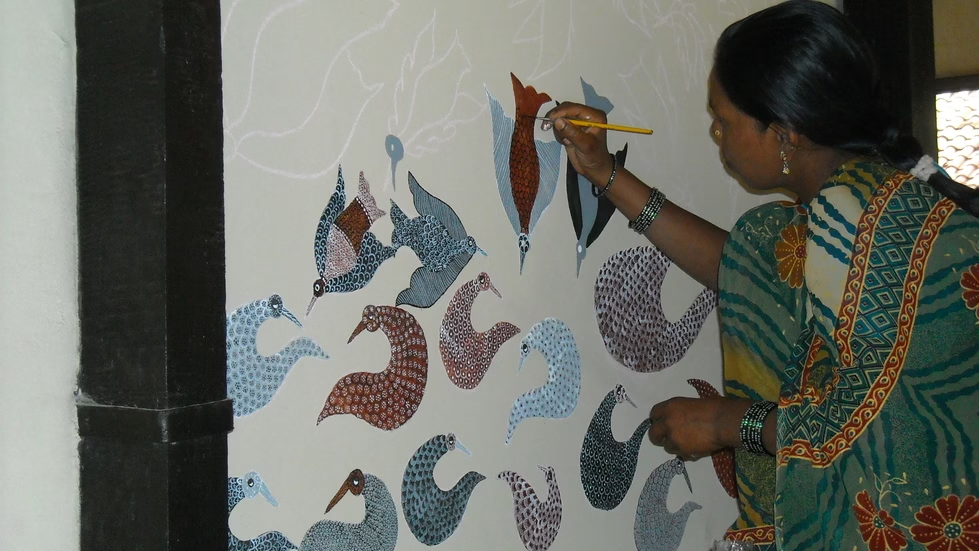
Creating a Gond Painting is a slow, patient process filled with meaning. Each artist brings their own rhythm to the canvas. Every line, curve, and dot tells a story about nature, faith, or life in the forests of Madhya Pradesh.
🖋️ Step 1: Preparing the Surface
- Earlier, artists would smoothen mud walls and apply a thin layer of cow dung or clay before painting.
- For modern artworks, paper or canvas is prepared using a light coat of white paint to make colors stand out vividly.
🪶 Step 2: Drawing the Outline
- The artist begins by drawing fine outlines of animals, trees, birds, or deities using a black or dark color.
- These outlines are not traced but drawn freehand—showing the confidence and creativity of the artist.
- Each design reflects stories from folklore, nature, or tribal rituals.
🟢 Step 3: Filling with Colours
- Once the outline is ready, natural or acrylic colors are filled carefully inside the shapes.
- Each section is painted with great patience, often in contrasting shades to bring the design to life.
- The choice of color depends on the mood of the story—bright hues for joy, earthy tones for calmness.
🔹 Step 4: Adding Patterns and Details
- This is the most important stage that makes Gond Painting unique.
- Artists fill the shapes with tiny dots, lines, curves, and dashes all drawn in rhythm and harmony.
- These repeating patterns give movement to still figures, making animals look like they’re breathing and trees like they’re swaying.
🌈 Step 5: Final Touches and Drying
- Once the detailed patterns are complete, the painting is left to dry naturally.
- Sometimes, artists add a thin coat of varnish to protect the painting and enhance its shine.
- The final work radiates life, it feels as if each form has its own heartbeat.
🎨 Symbols and Motifs: The Language of Patterns and Beliefs
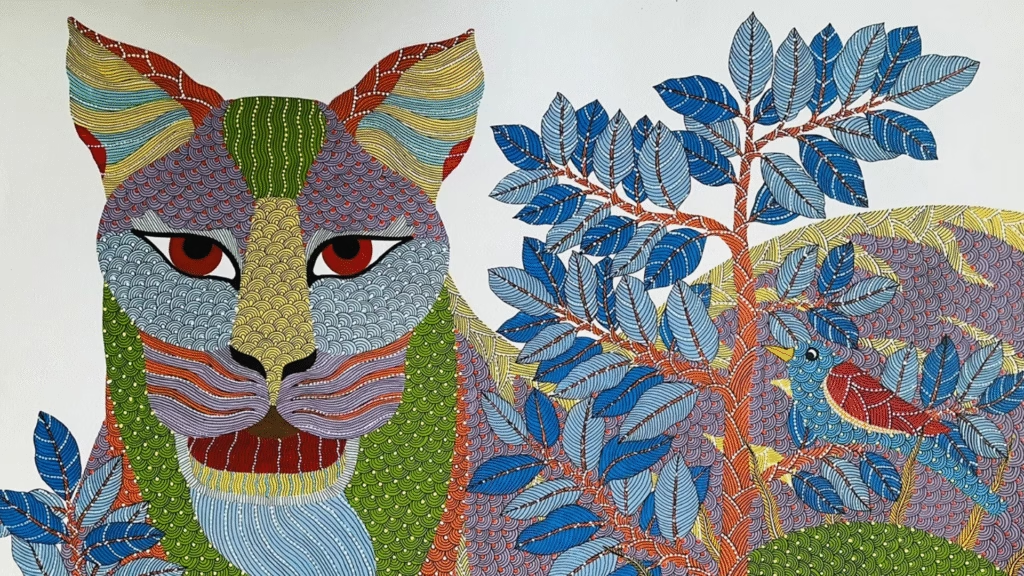
The Gonds, one of the largest tribal communities in India, express their connection with nature and spirituality through these living patterns. Let’s explore the fascinating symbols and motifs that make Gond art a language of its own.
🌳 1. Nature — The Heartbeat of Gond Painting
- Trees (Especially the Mahua and Banyan):
- Trees are sacred symbols in Gond Painting.
- They represent life, protection, and connection between humans, animals, and the divine.
- The Tree of Life is one of the most recurring motifs, showing how every living being depends on nature.
- Trees are sacred symbols in Gond Painting.
- Animals and Birds:
- Gonds believe animals are spiritual companions and protectors.
- Tigers symbolize power and guardianship.
- Peacocks stand for beauty and pride.
- Fish bring luck and abundance, while deer represent gentleness and grace.
- In every Gond Painting, animals are painted with vibrant colors and rhythmic patterns, making them look alive and full of energy.
- Gonds believe animals are spiritual companions and protectors.
- Mountains and Rivers:
- These elements show the natural environment that sustains the tribal community.
- Flowing rivers often symbolize life’s journey and continuity.
- These elements show the natural environment that sustains the tribal community.
☀️ 2. The Cosmic Connection in Gond Painting
- The Sun and Moon:
- Both are powerful symbols of time, rhythm, and divinity.
- The Sun stands for energy, hope, and renewal.
- The Moon, often shown with stars, represents calmness and dreams.
- Together, they express the balance of life — day and night, work and rest, creation and reflection.
- Both are powerful symbols of time, rhythm, and divinity.
- Dots, Lines, and Curves:
- These are the heartbeat of Gond Painting.
- The repetitive use of dots and lines adds rhythm and texture to the artwork.
- They also symbolize the continuous cycle of life — everything moving in harmony.
- These are the heartbeat of Gond Painting.
🕊️ 3. Faith, Beliefs, and Daily Life
- Gods and Spirits:
- Gond artists often paint local deities such as Phulwari Devi and Bada Dev, who are believed to protect the village and the forest.
- These figures are drawn with respect and devotion, surrounded by vibrant natural motifs.
- Gond artists often paint local deities such as Phulwari Devi and Bada Dev, who are believed to protect the village and the forest.
- Festivals and Community Life:
- Many motifs capture moments from festivals, dances, or agricultural activities.
- They celebrate togetherness, harvest, and gratitude towards nature.
- Many motifs capture moments from festivals, dances, or agricultural activities.
- Mythical Creatures and Legends:
- Some Gond Paintings depict mythological stories passed down through generations.
- These creatures symbolize courage, imagination, and the power of storytelling within the community.
- Some Gond Paintings depict mythological stories passed down through generations.
🌈 4. Colors That Speak
- Traditionally, colors in Gond Painting were made from natural materials like charcoal, plant leaves, cow dung, and flowers.
- Each color has a meaning:
- Red for life and energy
- Yellow for divinity
- Green for fertility and harmony
- White for purity and peace
- Red for life and energy
These colors and patterns together form the visual language of the Gonds — a way to express joy, faith, and respect for the world around them.
Preserving the Legacy: The Future of Gond Painting
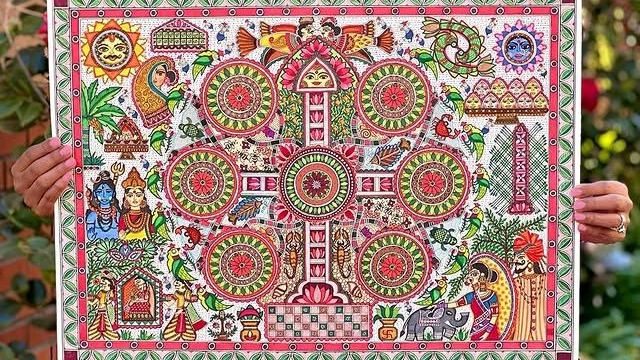
Gond Painting, a timeless expression of tribal creativity from Madhya Pradesh, stands today at a turning point balancing between tradition and transformation. Let’s explore how this art form continues to live, breathe, and evolve in a changing world.
🌿 The Need for Preservation
- Cultural Identity at Stake
- Gond Painting is not just art; it is the visual language of the Gond tribe.
- With modernization and migration, traditional knowledge risks fading away unless actively preserved.
- Gond Painting is not just art; it is the visual language of the Gond tribe.
- Loss of Oral Tradition
- Earlier, stories behind each Gond Painting were passed verbally.
- As younger generations move toward cities, these oral traditions are slowly diminishing.
- Earlier, stories behind each Gond Painting were passed verbally.
- Shift from Walls to Paper
- Originally painted on mud walls with natural colors, Gond Painting now often uses canvas or paper.
- While this helps the art reach global audiences, it also changes its natural and ritualistic essence.
- Originally painted on mud walls with natural colors, Gond Painting now often uses canvas or paper.
🎨 Modern Adaptations Keeping the Art Alive
- Contemporary Themes and New Mediums
- Today, artists depict not only nature and mythology but also modern life — vehicles, festivals, and daily routines — all within the Gond Painting style.
- Acrylic colors, canvas boards, and digital printing make the art more durable and marketable.
- Today, artists depict not only nature and mythology but also modern life — vehicles, festivals, and daily routines — all within the Gond Painting style.
- Younger Artists Joining the Movement
- Many young Gond painters from Madhya Pradesh are bringing fresh energy to the craft.
- They combine traditional motifs with urban stories, keeping Gond Painting both relevant and rooted.
- Many young Gond painters from Madhya Pradesh are bringing fresh energy to the craft.
- Women Artists Rising
- Earlier, men dominated this field, but now women artists are equally celebrated.
- Their detailed work often highlights emotions, home life, and connections with nature.
- Earlier, men dominated this field, but now women artists are equally celebrated.
🏛️ Government and Institutional Support
- Cultural Programs and Exhibitions
- The Government of Madhya Pradesh organizes annual fairs and exhibitions to promote Gond Painting nationally and internationally.
- These events create opportunities for tribal artists to showcase and sell their work directly.
- The Government of Madhya Pradesh organizes annual fairs and exhibitions to promote Gond Painting nationally and internationally.
- Art Training and Documentation
- NGOs and art institutions are training young tribal children in Gond Painting techniques.
- Digital archives and documentaries are being created to preserve traditional motifs and stories.
- NGOs and art institutions are training young tribal children in Gond Painting techniques.
- Recognition on Global Platforms
- Gond Painting now travels far beyond India — displayed in museums and art galleries around the world.
- Artists like Jangarh Singh Shyam have inspired international appreciation and academic study of this art form.
- Gond Painting now travels far beyond India — displayed in museums and art galleries around the world.
💡 The Path Forward: Sustaining Gond Painting
- Education and Awareness
- Introducing Gond Painting in school art curriculums can help children appreciate and learn this heritage early.
- Workshops and community art festivals can encourage interaction between tribal artists and the public.
- Introducing Gond Painting in school art curriculums can help children appreciate and learn this heritage early.
- Sustainable Marketing
- Fair trade platforms and online art marketplaces can ensure that genuine Gond artists earn fair income.
- Promoting eco-friendly materials, as in traditional practice, keeps both art and nature protected.
- Fair trade platforms and online art marketplaces can ensure that genuine Gond artists earn fair income.
- Digital Storytelling
- Virtual exhibitions, NFTs, and online classes now open new doors for Gond Painting’s global reach.
- Digital storytelling helps the world experience the magical patterns and colors of this ancient art.
- Virtual exhibitions, NFTs, and online classes now open new doors for Gond Painting’s global reach.
Conclusion
Lepakshi Murals are not just paintings, they are living echoes of history, faith, and imagination. Born from the stones of Andhra Pradesh, they reflect the devotion and artistry of generations who turned walls into storytelling canvases.
Every brushstroke narrates tales of gods, legends, and the divine dance of life. Though centuries have passed, their beauty still breathes through faded colors and sacred halls. Preserving Lepakshi Murals means preserving India’s spiritual artistry, a timeless reminder that stories carved in stone never fade; they continue to whisper the legacy of devotion, creativity, and cultural pride through every passing era.
Also read: Mud-Mirror Work from Kutch: A Living Artwork

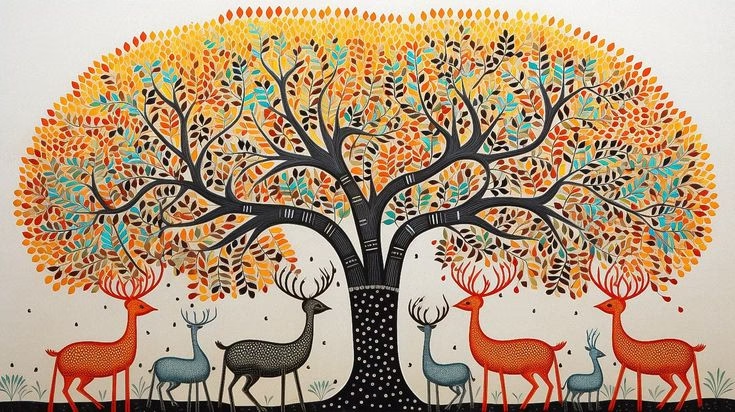
Leave a Reply